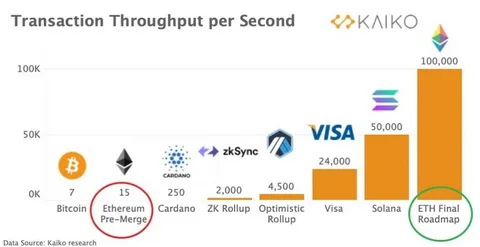Introduction
Ethereum, the world’s leading smart contract platform, has long faced challenges related to scalability and high transaction costs. As decentralized applications (dApps) continue to gain mainstream adoption, the need for Ethereum to process a massive number of transactions per second (TPS) becomes more critical.
Vitalik Buterin, the visionary co-founder of Ethereum, has repeatedly addressed these concerns and believes that “rollups” could be the key to scaling Ethereum to process over 100,000 transactions per second. This article delves into Buterin’s vision and explores whether Ethereum can truly achieve this ambitious target with rollups.

The Road to Scalability
The Scalability Problem in Ethereum
Ethereum has become the foundation for countless decentralized applications and financial systems. However, one of the platform’s biggest challenges is its scalability, a problem exacerbated by its popularity. As the number of users and transactions on the Ethereum network increased, so did congestion and gas fees, making the network less accessible for everyday users.
Currently, Ethereum processes around 15-45 transactions per second (TPS) depending on network conditions. In contrast, centralized payment systems like Visa can handle up to 24,000 TPS, highlighting the need for Ethereum to find a way to scale without compromising decentralization or security.
This is where rollups, an innovative Layer 2 (L2) scaling solution, enter the picture. According to Buterin, Ethereum’s Layer 2 rollup technology could be the answer to scaling Ethereum to a TPS rate of over 100,000, transforming the network into a robust infrastructure capable of supporting global applications.
What Are Rollups?
Rollups are a Layer 2 solution designed to offload the bulk of computational work and transaction processing from the Ethereum mainnet, thus reducing congestion. There are two main types of rollups: Optimistic Rollups and ZK-Rollups (Zero-Knowledge Rollups).
- Optimistic Rollups: These rollups assume transactions are valid by default and submit the results back to the main Ethereum chain. They rely on a fraud-proving mechanism that allows validators to challenge incorrect transactions, ensuring the system’s integrity.
- ZK-Rollups: In contrast, ZK-Rollups use cryptographic proofs to verify that transactions are correct without needing to challenge individual transactions. These proofs are submitted to Ethereum, which confirms their validity. ZK-Rollups are generally considered more efficient in terms of security and speed.
By leveraging rollups, Ethereum could offload a significant portion of transaction processing from its mainnet, drastically improving its TPS.
Vitalik Buterin’s Vision for Ethereum
Vitalik Buterin has outlined his vision for Ethereum’s scalability on several occasions. One of the core pillars of his plan revolves around the use of rollups. Buterin envisions an Ethereum network where most transactions occur off-chain through rollups, while the Ethereum mainnet remains secure and decentralized.
In Buterin’s vision, rollups will allow Ethereum to process not just hundreds or thousands of transactions per second, but upwards of 100,000 transactions per second. This is a staggering increase from its current TPS, making Ethereum as scalable as centralized financial networks while maintaining the benefits of decentralization.
Buterin’s confidence in rollups stems from their ability to reduce congestion on the mainnet while maintaining security. Since rollups execute most transactions off-chain and only submit summary proofs to the Ethereum blockchain, they can scale the network without increasing its size or computation load significantly. This allows Ethereum to remain decentralized even as it grows to support more users and applications.
Can Ethereum Achieve 100K Transactions Per Second?
The Rollups in Action
Several Layer 2 solutions are already using rollup technology to enhance Ethereum’s scalability. Projects such as Optimism and Arbitrum have successfully implemented Optimistic Rollups, while zkSync is utilizing ZK-Rollups. These projects have demonstrated that rollups can indeed scale Ethereum without sacrificing security.
Optimistic Rollups, for example, have already shown they can process transactions more efficiently than the Ethereum mainnet, reducing gas fees and increasing throughput. ZK-Rollups, meanwhile, offer even greater potential, as their cryptographic proofs can be verified much faster and with lower resource consumption.
Sharding and Rollups: The Perfect Combination?
While rollups alone can significantly improve Ethereum’s transaction throughput, Vitalik Buterin has suggested that combining rollups with Ethereum 2.0’s sharding mechanism could be the ultimate scalability solution.
Sharding is another key component of Ethereum 2.0, dividing the Ethereum network into multiple shards, each capable of processing its own set of transactions. By combining rollups and sharding, Ethereum could scale even further. In this scenario, each shard would process transactions in parallel, and rollups would handle transaction verification off-chain, minimizing the load on the Ethereum mainnet.
With both sharding and rollups, Buterin believes Ethereum could reach a TPS rate of 100,000 or more, allowing it to handle even the most demanding decentralized applications without issue.
Challenges on the Road to 100K TPS
Security Considerations
While rollups offer an impressive scaling solution, they come with their own set of challenges, particularly regarding security. Optimistic Rollups rely on a fraud-proof mechanism to ensure the validity of transactions. This system is secure in theory, but it could introduce delays and inefficiencies if malicious actors attempt to exploit the network.
ZK-Rollups, though more efficient, are highly complex, requiring advanced cryptographic proofs that are still being optimized for real-world use. The complexity of these cryptographic techniques raises concerns about their long-term security and scalability.
Moreover, the Ethereum ecosystem needs to ensure that its rollup implementations remain decentralized. As more transactions move off-chain, there is a risk that centralization could occur on the rollup layer, undermining Ethereum’s decentralized ethos.
Adoption and User Experience
Even if Ethereum achieves its goal of scaling to 100,000 TPS, its success will ultimately depend on user and developer adoption. Layer 2 solutions like rollups must be easy to use, not just for developers but also for everyday users. High gas fees and complex onboarding processes could hinder rollup adoption, limiting their effectiveness in scaling Ethereum.
To achieve mass adoption, Ethereum’s rollup solutions will need to integrate seamlessly with the current ecosystem of wallets, dApps, and exchanges. This will require extensive development and collaboration between Ethereum’s core developers and the broader crypto community.
Conclusion: Will Vitalik Buterin’s Vision Become Reality?
Vitalik Buterin’s vision for Ethereum is bold. By combining rollups with sharding, he believes Ethereum can scale to handle over 100,000 transactions per second. Rollups offer a powerful solution to Ethereum’s scalability challenges, and with continued development, they could enable Ethereum to support decentralized applications at a global scale.
However, the road to 100K TPS is not without challenges. Security concerns, user adoption, and the complexity of rollup technology must be addressed before Ethereum can achieve its full potential. Yet, with the ongoing development of Layer 2 solutions like Optimism, Arbitrum, and zkSync, Ethereum is well on its way to becoming a scalable, secure, and decentralized platform for the future of decentralized finance (DeFi) and beyond.
Do you believe Vitalik Buterin’s vision for Ethereum’s scalability will become a reality? Leave your thoughts in the comments below and join the discussion!






